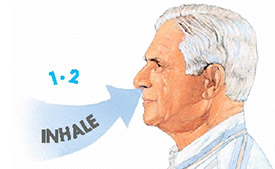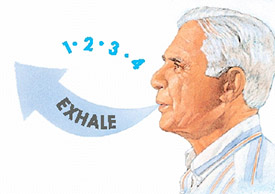You can learn to manage your breathing through pulmonary rehabilitation, which is a medically supervised program to help people with lung diseases improve their overall physical, mental, and social functioning.
The goals of a pulmonary rehabilitation program are to help you improve your functional capacity and help you understand and manage your disease. Therapists will teach you about your lungs and how to exercise and do activities with less shortness of breath.
Many hospitals and health care providers offer pulmonary rehabilitation services. Ask your health care team for ones in your area that you may be eligible for.
BREATHING STRATEGIES
While in pulmonary rehab, you’ll learn strategies that can improve your breathing. For example, pursed-lip breathing decreases how often you take breaths and keeps your airways open longer. This allows more air to flow in and out of your lungs so you can be more physically active.
To do pursed-lip breathing, you breathe in through your nostrils.

Then you slowly breathe out through slightly pursed lips, as if you’re blowing out a candle. You exhale two to three times longer than you inhale.

Some people find it helpful to count to two while inhaling and to four or six while exhaling.
Components of the Program
A physician-supervised program begins with an initial assessment by a registered nurse and exercise physiologist. The central components are a safe, supervised plan and exercise tailored to each patient and monitored by a team of professionals trained in chronic lung diseases.
In addition, a full range of group education classes (including nutrition, medications, chest physiotherapy, anatomy and physiology of the respiratory system, inspiratory muscle training, etc.) may be available and taught by a dietitian, health psychologist, nurses, and exercise physiologists.
What Are the Benefits?
The focus is to combine exercise and education to help you manage your disease and increase your quality of life. It may not sound like much, but 30% improvement in your ability to walk allows you to get your daily activities done without as much fatigue, shortness of breath, and anxiety.
Pulmonary rehab exercises increase your heart, lung, and circulatory functioning level. Start at a slow, comfortable pace, and gradually increase your time and intensity. Consult with your medical care provider prior to starting any exercise program.
What to Expect
Pulmonary rehabilitation can have many parts, and not all programs offer every part. Here are some of the elements a pulmonary rehabilitation program may include.
Exercise Training
Your rehabilitation team will give you a physical activity plan tailored to your needs. They’ll design the plan to improve your endurance and muscle strength, so you’re better able to carry out daily activities.
The plan will likely include exercises for both your arms and legs. You might use a treadmill, stationary bike, or weights to do your exercises.
If you can’t handle long exercise sessions, your plan may involve several short sessions with rest breaks in between.
While you exercise, your team may check your blood oxygen levels with a device that’s attached to your finger. You’ll probably have to do your exercises at least three times a week to get the most benefits from them.
Nutritional Counseling
The data your pulmonary rehabilitation team gathers when you start the program will show whether you’re overweight or underweight.
Both of these conditions can make it hard for you to breathe. If you’re overweight, fat around your waist can push up against your diaphragm, giving your lungs less room to expand during breathing. Your team may recommend a healthy eating plan to help you lose weight.
You also can have breathing problems if you’re underweight. Some people who have chronic (ongoing) lung diseases have trouble maintaining weight. If you lose too much weight, you can lose muscle mass. This can weaken the muscles used for breathing.
If you’re underweight, your team may recommend a healthy eating plan to help you gain weight. They also may give you nutritional supplements to help you avoid weight loss and loss of muscle mass.
Energy-Conserving Techniques
One way to help prevent symptoms like shortness of breath is to find easier ways to do daily tasks. Pulmonary rehabilitation programs often give you tips on how you can conserve your energy and breathe easier.
These tips include ways to avoid reaching, lifting, and bending. Such movements use energy and tighten your abdominal muscles, making it harder for you to breathe.
Stress also can use up energy and make you short of breath. Many pulmonary rehabilitation programs teach relaxation skills and ways to avoid or relieve stress.
